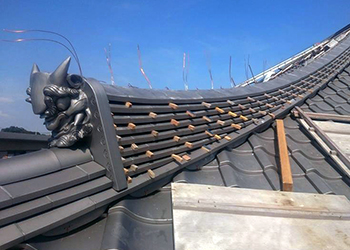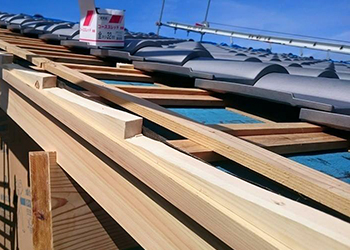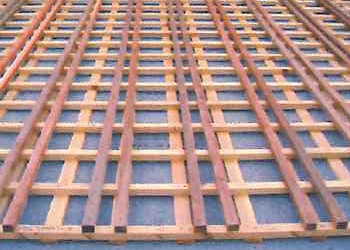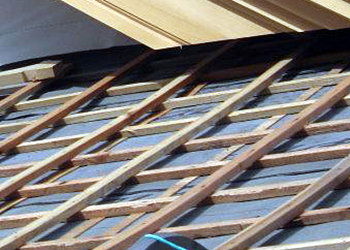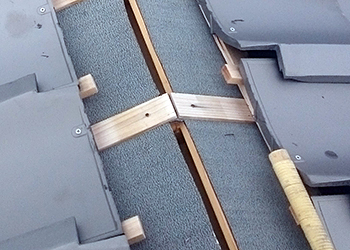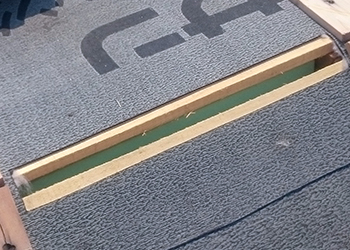
家族を守る瓦の家は、
災害にも強い。
Roof Tiles Protect the Family and Are Also Strong against Disasters.
瓦は重いから地震に弱い。雨漏りが多い。そんなイメージを持たれている方もいらっしゃると思います。
しかし、それは勘違いなのです。
昭和初期まで主流だった工法では、大量の土を載せるためかなりの重量がありましたが、それでも地震対策としては上下の揺れを防ぐと言われていました。また土の経年劣化により雨漏りにつながるケースもありましたが、これはメンテナンスの問題で一般的な屋根にも言えることです。
近年はさらに進化かつ大河瓦オリジナルの工法を用い、耐風、耐震性がさらに強靭なものになっています。また瓦そのものは、一般的なスレート材より耐久性が高く、耐火性、断熱性、防音性にも優れている素材です。
瓦そのものが持つ防災性と最新の工法が生み出す対災害性能で、施主様の大切な家族や財産を守ります。
Tiles are heavy and therefore vulnerable to earthquakes. There are many leaks. Some people may have this image. Actually, however, this is a misconception. The construction method that was mainstream until the early Showa period was quite heavy because it involved piling up a large amount of earth, but it was still said to be effective in preventing vertical shaking as an earthquake countermeasure. The construction method that was mainstream until the early Showa period was quite heavy because it involved piling up a large amount of earth, but it was still said to be effective in preventing vertical shaking as an earthquake countermeasure.
In recent years, the original construction method of Taiga Kawara has evolved even further, making it even more resistant to wind and earthquakes. Furthermore, the tiles themselves are more durable than ordinary slate, and they also have excellent fire resistance, heat insulation and soundproofing properties.
The disaster prevention properties of the tiles themselves and the disaster resistance performance created by the latest construction methods protect the client's important family and property.
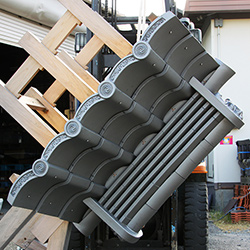
大河瓦の施工は仮に屋根を縦に起こしても、瓦の落下やズレが生じることはありません。これは耐震性・耐風性に優れ、強い屋根である証です。
With Taiga Kawara construction method, even if the roof is raised vertically, the tiles will not fall or shift. This is proof that the roof is strong and resistant to earthquakes and wind.
『工法』へのこだわり
Commitment to 'Construction Methods'
お客様が一番心配される耐震性や防火性、台風などの災害対策。大河瓦では公式な屋根に関するガイドライン以上の施工で安全を考えています。瓦だけでなく、下地の瓦桟木や釘、ビスや銅線などの緊結材も災害時に安全なものを使用しています。屋根瓦は正しく施工されれば災害にも強い屋根となります。
Our customers are most concerned about earthquake resistance, fire resistance, and disaster prevention measures such as typhoon protection. Taiga Kawara considers safety by constructing to a level that exceeds official guidelines for roofs. Not only the roof tiles, but also the base materials such as the roof tile battens, nails, screws and copper wire are made from materials that are safe in the event of a disaster. Properly installed roof tiles make a roof that is resistant to disasters.
『下地』へのこだわり
Commitment to 'Foundation'
仕上がれば隠れてしまう下地。しかしここを丁寧に仕事することで、仕上がりの美しさやランニングコストの低下に繋がります。通常は横のみで組まれる下地も、大河瓦では縦横で格子状に組み上げ、耐震などの耐久性を向上させる下地を作り上げます。見えないことからおろそかにされがちですが、細心の心配りで大切に作業します。
The foundation is hidden once the roof is finished. However, careful work here leads to a beautiful finish and lower running costs. Normally, the foundation is laid out horizontally only, but Taiga Kawara lays it out in a grid pattern, both horizontally and vertically, to create a foundation that improves durability, such as in terms of earthquake resistance. Although it is often neglected because it is invisible, we work on it with the utmost care.
『省エネ』へのこだわり
Commitment to 'Energy Conservation'
古くから日本で選ばれてきた屋根瓦は、夏涼しく冬暖かい特性を持っています。これは瓦屋根の無数の重なりが空気の流れを作り、自然換気を促すからです。大河瓦の換気システムはオリジナル工法かつ既製品を使わないので、換気性能が特に優れた屋根となります。天然のエアコンディショニング機能は省エネで快適です。
Roof tiles have been chosen in Japan since ancient times for their ability to keep buildings cool in summer and warm in winter. This is because the countless overlapping of the tile roofs creates air flow, promoting natural ventilation. The ventilation system of Taiga Kawara is an original construction method that does not use off-the-shelf products, so the roof has particularly excellent ventilation performance. The natural air conditioning function is energy-saving and comfortable.

